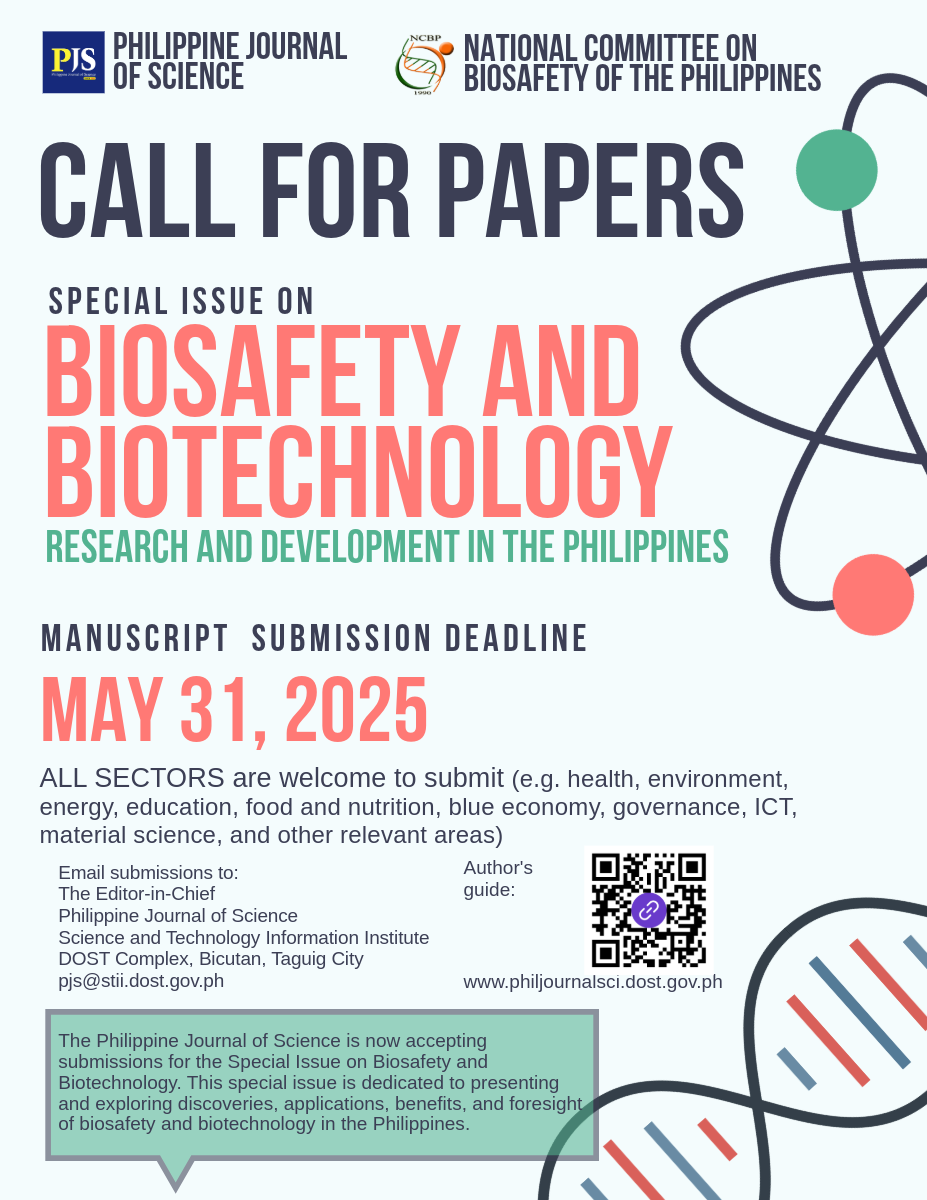Selected Philippine Plant Extracts as Alternative
Preservatives for a Pharmaceutical Liquid Preparation
Erna C. Arollado*1, 2, Leslie P. Bucog1, Richelle Ann M. Manalo1,
Irizh-Lyn R. Sampang1, and Janvin Jessel A. Cariscal1
1National Institutes of Health – Institute of Pharmaceutical Sciences
2College of Pharmacy, University of the Philippines Manila
*Corresponding author: This email address is being protected from spambots. You need JavaScript enabled to view it.
ABSTRACT
Preservatives play an essential role in enhancing quality and prolonging shelf-life of pharmaceutical products by improving their antimicrobial stability or reducing the amounts of oxidative degradation products. Persistent use of synthetic compounds as preservatives resulted in several reports of undesirable effects. Hence, development of alternatives is necessary to maintain their vital function while minimizing adverse effects. In this study, ethanolic extracts of five plants with known antimicrobial activities, Psidium guajava, Premna odorata, Mimosa pudica, Allium sativum and Zingiber officinale, were formulated into suspensions and evaluated for preservative activity using the United States Pharmacopeia (USP) (2015) guidelines. Phytochemical test, antioxidant activity and compatibility test were also conducted on the extracts. Premna odorata (p=0.999) and Mimosa pudica (p=0.054) at 5.00 mg/mL concentration exhibited comparable antioxidant activity against the standard antioxidant preservative, butylated hydroxytoluene, using ferric reduction antioxidant power assay. Based on the criteria for product category 4 of the USP, suspensions of Premna odorata and Psidium guajava demonstrated acceptable preservative activity against selected microorganisms, Escherichia coli and Staphylococcus aureus. These bioactivities can be attributed to the phytochemicals present in the extracts such as glycosides, reducing substances, flavonoids and alkaloids. In conclusion, for the USP category 4 products such as antacid suspensions, Psidium guajava can be utilized as an alternative source of antimicrobial preservative, Mimosa pudica as an alternative source of antioxidant preservative, and Premna odorata as an alternative source of preservative with both antimicrobial and antioxidant efficacy.
INTRODUCTION
The pharmaceutical industry utilizes preservatives on their products to improve quality by retaining color, texture and flavor, and prolong shelf-life. Pharmaceutical preparations are prone to the growth of microorganisms due to contamination while frequent exposure to light and air may yield products of oxidative degradation, both of which are detrimental to the health of consumers. Synthetic or chemical preservatives, such as bisulfites, nitrates, butylated hydroxytoluene (BHT), benzoic acid, methylparaben and propylparaben, have been used for decades in pharmaceutical preparations (Abdel-Azi et al. 2016) and thus, are readily available. Their mechanisms of action are based on their antioxidant, antimicrobial or anti-enzymatic properties. . . . . . read more
REFERENCES
ABDEL-AZI SM, AERON A, KAHIL TA. 2016. Health benefits and possible risks of herbal medicine. In: Microbes in Food and Health. Garg N, Abdel-Azi SM, Aeron A eds. Switzerland: Springer International Publishing. 98p.
ABIRAMI SKG, MANI KS, DEVI MN, DEVI PN. 2014. The antimicrobial activity of Mimosa pudica L. IJAPR 2(1): 105 - 108.
ANANDHI D, SRINIVASAN PT, KUMAR GP, JAGATHEESH S. 2014. Influence of flavonoids and glycosides from Caesalpinia coriaria (Jacq) wild as bactericidal compound. Int J Curr Microbiol App Sci 3(4): 1043 - 1051.
BREWER MS. 2011. Natural antioxidants: sources, compounds, mechanisms of action and potential applications. Compr Rev Food Sci Food Saf 10(4): 221-247.
CHEN HY, YEN GC. 2007. Antioxidant activity and free radical-scavenging capacity of extracts from Guava (Psidium guajava L.) leaves. Food Chem 101: 686 – 694.
CUSHNIE T, CUSHNIE B, LAMB AJ. 2014. Alkaloids: an overview of their antibacterial, antibiotic-enhancing and antivirulence activities. Int J Antimicrob Agents 44: 377 - 386.
ENWA FO, OMOJATE GC, JEWO AO, EZE CO. 2014. Mechanisms of antimicrobial actions of phytochemicals against enteric pathogens – a review. J Pharm Chem Biol Sci 2(2): 77 - 85.
GHARAVI N, HAGGARTY S, EL-KADI AO. 2007. Chemoprotective and carcinogenic effects of tert-butylhydroquinone and its metabolites. Curr Drug Metab 8(1): 1 - 7.
JOHNSON K, NARASIMHAN G, KRISHNAN C. 2014. Mimosa pudica Linn – a shyness princess: a review of its plant movement, active constituents, uses and pharmacological activity. IJPSR 4:5104 - 5118.
KARRUPIAH P, RAJARAM S. 2012. Antibacterial effect of Allium sativum cloves and Zingiber officinale rhizomes against multiple-drug resistant clinical pathogens. Asian Pac J Trop Biomed 2(8): 597 - 601.
MCCANN D, BARRETT A, COOPER A, CRUMPLER D, DALEN L, GRIMSHAW K. 2010. Food additives and hyperactive behavior in 3-year old and 8/9-year-old children in the community: a randomised, double-blinded, placebo-controlled trial. Lancet 370(9598): 1560 - 1567.
NAWAR WF. 1996. Lipids. In: Food Chemistry, 3rd ed. Fennema O, ed. New York: Marcel Dekker, Inc. p. 225 - 320.
OTSUKA H, KUBO N, YAMASAKI K, PADOLINA WG. 1989. Two iridoid glycoside caffeoyl esters from Premna odorata. Phytochem 28(2): 513 – 515.
PINZON LC, UY MM, SZE KH, WANG M, CHU IK. 2011. Isolation and characterization of antimicrobial, anti-inflammatory and chemopreventive flavones from Premna odorata Blanco. J Med Plants Res 5(13): 2729 – 2735.
RATTANACHAIKUNSOPON P, PHUMKHACHORN P. 2010. Contents and antibacterial activity of flavonoids extracted from leaves of Psidium guajava. J Med Plants Res 4(5): 393-396.
SHEE AK, RAJA RB, SETHI D, KUNHAMBA A, ARUNACHALAM KD. 2010. Studies on the antibacterial activity potential of commonly used food preservatives. Int J Eng Sci 2(3): 264 - 269.
SUBHASHINI N, THANGATHIRUPATHI A, LAVANYA N. 2011. Antioxidant activity of Trigonella foenum graecum using various in vitro and ex vivo models. Int J Pharm Pharm Sci 3(2): 96 - 102.
TREASE GE, EVANS WC. 1989. Pharmacology, 11th ed. London: Baillere Tindall Ltd. p. 60 – 75.
[USP 38 – NF 32] United States Pharmacopeia 38 – National Formulary 32. 2015. Chapter 51. Antimicrobial effectiveness test. United States Pharmacopeial Convention. p. 100 - 103.
WILSON BG, BAHNA SL. 2005. Adverse reactions of food additives. Asthma Immunol 95: 499 - 507.









